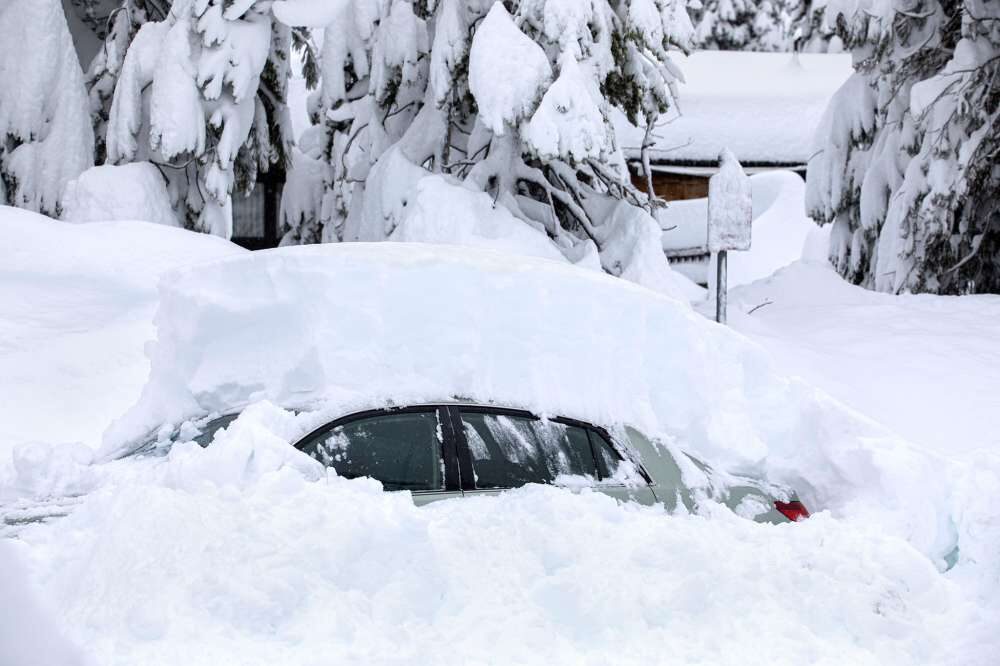Today, the scenery looks entirely different. The Sierra Nevada mountains are painted white. Roads are like tunnels between tall snowbanks. Tree boughs are heavy with snow. And the mountains are donning a white coat, winter's finest.
Lake Tahoe received somewhere between 4 and 8.5 feet of snow in five days, according to Bryan Allegretto, who forecasts and tracks snowfall in the Lake Tahoe region for Open Snow. On Thursday morning, snowflakes continued to fall lightly, a quiet cap to a fierce storm that jump-started winter from hardly a pulse to fully alive.

For tourism-centric businesses in Lake Tahoe, the two weeks of Christmas and New Year's are likely the busiest time of the year. It's a 10-day sprint that most businesses rely on to carry them through the rest of the winter, until summer picks up a busy, steady pace again. Having enough snow to lure skiers and snowboarders to Tahoe is an economic boom that cannot be underestimated. And tourism is still the lifeblood of Lake Tahoe's economy, even though research shows the critical need to diversify so that businesses are not so reliant on factors beyond their control, like winter storms or a pandemic.
In this storm, Mount Rose saw the most snowfall, by far, according to Allegretto's data. Between Sunday and Wednesday, some 6.5 feet of snow accumulated at the highest elevations on Mount Rose. On the southern end of Tahoe, Kirkwood received 61 inches of snow, more than 5 feet. And to the north, Sugar Bowl received 55 inches, about 4.5 feet. Snow continued to fall on Wednesday night and into Thursday morning, elevating the snow totals even more.
This kind of a storm isn't unprecedented in December, said Andrew Schwartz, lead researcher at the UC Berkeley Central Sierra Snow Lab on Donner Summit. At the snow lab, Schwartz continued the decades-old tradition of measuring snowfall at 8 a.m., keeping the lab's longtime set of data about snowfall alive. In the past week, including a smaller storm before the atmospheric river arrived on Sunday, the snow lab received nearly 80 inches of snow, more than 6.5 feet.
All over the Lake Tahoe and Truckee region, people have been working around the clock, 24/7, to dig out homes and cars, plow roads and driveways, push snow into massive snow banks to clear parking lots.


The speed at which Lake Tahoe comes to life and recovers back to its usual pace after such a monstrous storm can feel miraculous. But it is no miracle, just a finely tuned, well-proven system.
However, sometimes Mother Nature arrives at such a force that man-made systems stand no chance. This week, thousands of people lost electricity across the Sierra Nevada, on the western slope and in the Tahoe Basin, from Portola down to South Lake Tahoe, because power lines and poles fell down in powerful gusts and winds.

On Interstate 80, a live electric wire fell across all lanes of traffic on Monday night, a Caltrans spokesperson said, shutting down the highway for 8 hours as a crew from PG&E arrived to fix the wire, which was shooting out sparks.
In the mountains, the snowpack has settled over the course of the week and the danger posed by avalanches has dropped, if only slightly. On Tuesday, the Sierra Avalanche Center, a nonprofit organization that studies the snowpack in the Tahoe region and issues in-depth reports every day all winter long about avalanche danger, rated avalanche danger as "high." On Thursday, the rating was "considerable," one level below "high" and a number 3 on a scale of 1 to 5, with 5 being the most dangerous.
According to the Utah Avalanche Center, risk of avalanches increases twofold for every step on the five-part scale. Most fatalities from avalanches occur when the hazard rating is "considerable."
In light of the new snow, with an expectation of more people recreating in the mountains over the holiday season, Take Care Tahoe is hosting its second annual Tahoe Backcountry Safety Awareness Week, with videos and live events created to educate viewers about the risks of recreation in the winter backcountry, beyond the ski resort boundary.
Even inside the ski resort boundary, this much snowfall is a double-edged sword.
Palisades Tahoe said this storm is enabling them to open a lot more terrain, on both the Olympic Valley side and the Alpine Meadows side.
"This storm will just mean we'll be able to expand to a bigger amount of skiable terrain quicker," said Alex Spychalsky, spokesperson for Palisades Tahoe. However, this much snow in just a few days creates a logistical issue, Spychalsky added.
"We are going to be relying heavily on our operations teams — ski patrol, grooming, snowmaking, lift ops and lift maintenance — to be out on the hill assessing the conditions and dictating what we're able to open," Spychalsky said. "It takes several feet of snow to even begin all of the on-hill work necessary to open new terrain, so that is not work that we can do before the storm. ... Then, with the amount of snow this storm is bringing us, we need to perform avalanche mitigation throughout the storm cycle, clear lifts of rime ice and continually rebuild those access roads as new snow comes in."
More winter storms are in the forecast for next week, though it's still early to definitively predict snowfall amounts.
For those coming up to Tahoe, excited to recreate in all this storm, a word of advice: Patience is key. And also, please drive slowly, with chains or four-wheel drive.





Reader Comments